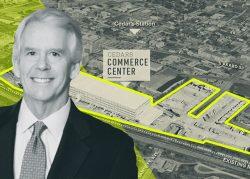James Campbell Company struck a suburban Chicago industrial deal for a profit that more than made up for a recent loss it took on an area sale of an office.
The Hawaii-based firm sold a 215,000-square-foot warehouse on the southern edge of O’Hare International Airport at 10600 West Belmont Avenue in Franklin Park for $30.3 million to LBA Logistics, public records show.
With the deal, James Campbell joins the crowd of industrial real estate players to have more than doubled or even tripled their investments on Chicago-area assets bought within the last decade and sold this year. The company picked up the property for a little less than $8 million in 2012.
The sector became coveted amid the pandemic as office deals lost allure. It remains supply-constrained, especially in the crowded O’Hare submarket, which dipped below 2 percent vacancy in the second quarter for the first time ever, according to Colliers.
When James Campbell sold the Highland Landmark II office building in the Chicago suburb of Downers Grove to Opal Holdings for $52 million late last year, the firm took a loss of about $10 million from its 2014 purchase of the property.
Neither James Campbell nor LBA returned requests for comment on the Franklin Park deal.
LBA’s newest property is “in one of the Chicago area’s deepest and tightest industrial submarkets,” said Colliers broker Jeff Devine, who represented James Campbell in the sale.
The Irvine, California-based firm’s purchase shows confidence from a major industrial investor that values will continue marching upward or at least hold steady for the next several years, even after they’ve surged over the past two.
Signs of a slowdown have started to emerge for warehousing, though, as rising interest rates have forced brokers to realign the pricing expectations of buyers and sellers in some cases.
Furthermore, Amazon, one of the nation’s biggest occupiers and owners of industrial property, has pulled back following a real estate splurge, including ditching plans to build warehouses of 180,000 square feet and 250,000 square feet, respectively, in Chicago’s northwest suburbs of Crystal Lake and Hoffman Estates.
Developers have already reacted to the shift, though. While larger spaces of 150,000 to 250,000 square feet have experienced the most prevalent demand since about 2017, there’s been a renewed desire for smaller industrial projects of 50,000 to 90,000 square feet, according to JLL. They’re emboldened by rising rents to pursue new builds on speculation with no pre-leasing, even with smaller warehouses offering more risk and less profit.
“Developers are willing to take the risk due to user demand, despite smaller margins, because of the rent delta. We are even starting to see speculative projects below 50,000 square feet,” JLL’s Chad Buch said.
Read more


